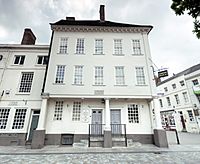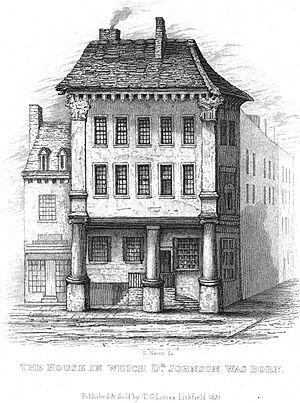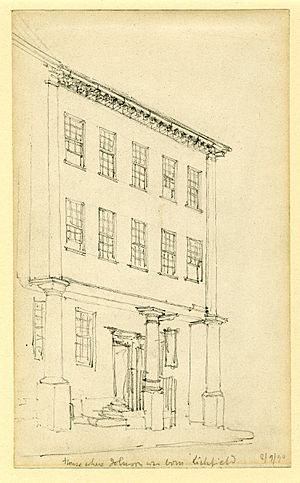Samuel Johnson Birthplace Museum facts for kids
 |
|
| Established | 1707 (House) 1901 (Museum) |
|---|---|
| Location | Breadmarket Street, Lichfield, Staffordshire, England |
| Type | Biographical Museum |
| Collection size | 8,000 items |
| Visitors | 16,000 |
The Samuel Johnson Birthplace Museum is a special museum and bookshop in Lichfield, England. It's in a very old building, built in 1707, that is considered a Grade I listed building. This means it's a really important historical place! The museum opened its doors in 1901.
It celebrates the life and work of Samuel Johnson, a famous writer and dictionary maker. He created the very first important Dictionary of the English Language. Samuel Johnson was born in this house on September 18, 1709. He lived here for most of his first 27 years before moving to London in 1737. After he passed away in 1784, the house was used for different shops. But in 1900, a kind person named John Gilbert bought it for the city. He wanted it to become a museum to remember Johnson. Today, it's still a busy museum!
The House's Design
Samuel Johnson's father, Michael, built this house in 1707. It stands right on a corner in Lichfield. The house was made with a timber frame and bricks, but now it's covered in a smooth finish called stucco. It has four floors, and the top floor used to have special windows called dormer windows. These were removed a long time ago but put back in the 1970s.
The front of the house faces the Market Square. The upper floors stick out a bit over the ground floor. When it was first built, pillars supported this part. Over the years, the outside of the house changed a few times. It was originally red-brown brick with blue-black roof tiles. In the 19th century, the outside was covered in stucco, giving it a new look.
A Look at History
Before It Was a Museum
The house was built in 1707 by Michael Johnson, Samuel's father. It was both their home and a bookshop. Samuel Johnson was born here on September 18, 1709. He spent most of his childhood and early adult life in this house. He left for London with his friend David Garrick on March 2, 1737, when he was 27.
Samuel's mother, Sarah, continued to live in the house after he left. Later, Samuel and his mother borrowed money, using the house as a guarantee. Samuel eventually paid back this loan completely. After his mother passed away in 1759, Samuel asked his stepdaughter and a family servant to look after the house and continue the bookshop.
We don't know exactly when the Johnson family stopped owning the house. It might have been Samuel's until he died in 1784. A year after his death, in 1785, the house was sold. A bookseller bought it and kept it as a bookshop. From 1817 to 1835, it was even the office for the Lichfield Mercury newspaper! After that, it was empty for a while or used for different businesses like a grocer or a dentist.
In 1887, a man named James Johnson bought the house. He wanted to save the place where Dr. Johnson was born. In 1900, thanks to John Gilbert, the house was sold to the city. On May 27, 1901, it officially opened as a museum dedicated to Samuel Johnson.
The Museum Today
The museum, which opened in 1901, has a huge collection of old papers and books. It includes over 1,000 books donated by the widow of Dr. Peter Hay Hunter in 1911. The city council managed the museum until 1974. Then, a special group called the Dr Johnson Birthplace Trust took over. The city council became the trustee again in 1982. The museum is also the mailing address for the Johnson Society, a group founded in 1910. The entrance to the bookshop was restored in 1990.
Today, the museum has many interesting displays, recreated rooms, and videos. Visitors can learn all about Samuel Johnson's amazing life. You can discover his challenging childhood, his struggles before becoming famous, and his eventual worldwide success. The museum's collection includes pictures, paintings, and sculptures. There's even a carved figure of Johnson by Denis Alva Parsons. You can also see furniture, old papers, and many rare editions of Johnson's books.
The museum has two main libraries filled with books, named after the people who donated them: the Hay Hunter and Blum Libraries. Another library, the Wood library, holds 2,000 more books. You can also see some of Johnson's personal items. These include his armchair, tea set, breakfast table, and a portable writing desk. There's even David Garrick's walking stick and a bookcase that belonged to James Boswell.
See also
- Grade I listed buildings in Staffordshire
- Listed buildings in Lichfield
- Samuel Johnson
- Early life of Samuel Johnson
- Dr Johnson's House in London; he lived and worked in the house from 1748 to 1759



